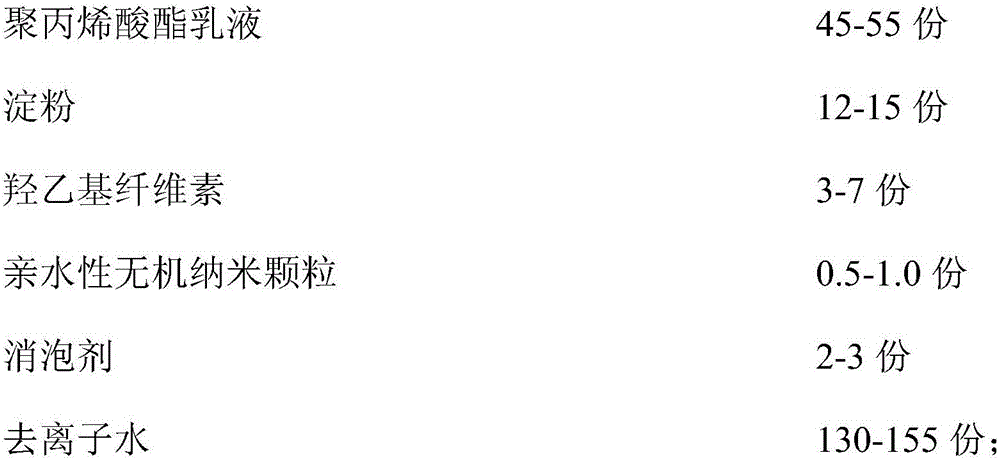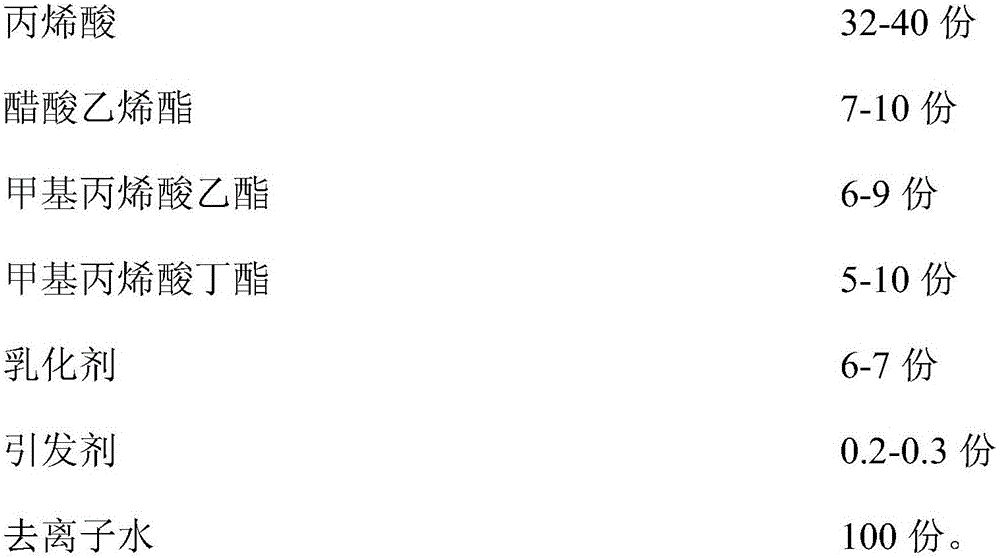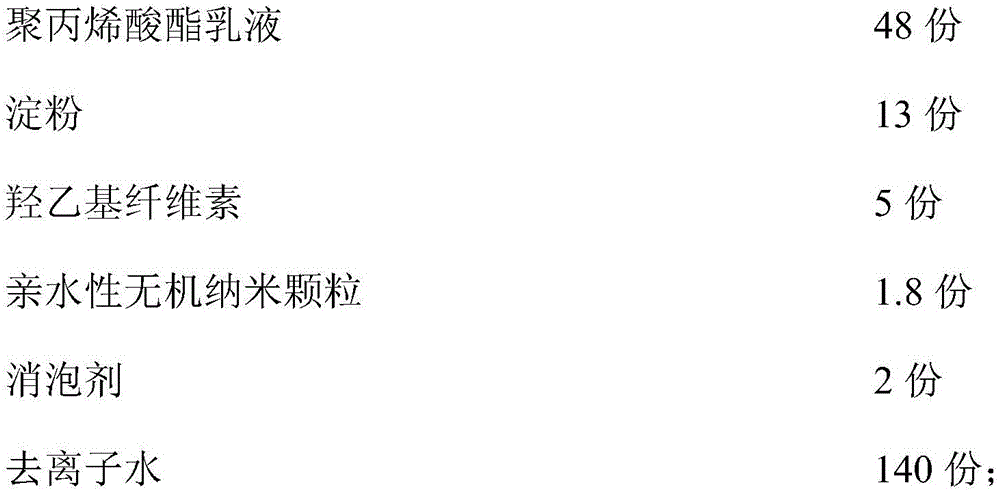Polyacrylic acid textile pulp
A technology of textile pulp and polyacrylic acid, applied in the field of polyacrylic acid textile pulp and textile pulp, can solve the problems of hygroscopicity, high re-viscosity, inconvenient use, poor fluidity, etc., and achieves good extensibility, low viscosity, good fluidity
- Summary
- Abstract
- Description
- Claims
- Application Information
AI Technical Summary
Problems solved by technology
Method used
Image
Examples
Embodiment 1
[0047] A textile slurry prepared from the following raw materials in parts by weight:
[0048]
[0049]
[0050] Wherein, the polyacrylate emulsion is prepared from the following raw materials in parts by weight:
[0051]
[0052] The emulsifier is sodium lauryl sulfate.
[0053] The initiator is ammonium persulfate.
[0054] The defoamer is dimethyl silicone oil.
[0055] The hydrophilic inorganic nanoparticles are inorganic nanoparticles whose surfaces are modified by hydroxyl groups, and the inorganic nanoparticles are silica; the particle size of the hydrophilic inorganic nanoparticles is 5-10 nm.
[0056] The preparation method of the polyacrylic acid textile size includes the following steps:
[0057] (1) Mix the formulated amount of polyacrylic acid, vinyl acetate, ethyl methacrylate, butyl methacrylate, emulsifier, initiator and deionized water, and react at 50°C to obtain a polyacrylate emulsion;
[0058] (2) Mix the formula amount of starch, hydroxyethyl cellulose and deionized w...
Embodiment 2
[0061] A textile slurry prepared from the following raw materials in parts by weight:
[0062]
[0063] Wherein, the polyacrylate emulsion is prepared from the following raw materials in parts by weight:
[0064]
[0065] The emulsifier is OP-10.
[0066] The initiator is ammonium persulfate.
[0067] The defoamer is dimethyl silicone oil.
[0068] The hydrophilic inorganic nanoparticles are inorganic nanoparticles whose surfaces are modified by hydroxyl groups, and the inorganic nanoparticles are titanium dioxide; the particle size of the hydrophilic inorganic nanoparticles is 20-40 nm.
[0069] The preparation method of the polyacrylic acid textile size includes the following steps:
[0070] (1) Mix the formula amount of polyacrylic acid, vinyl acetate, ethyl methacrylate, butyl methacrylate, emulsifier, initiator and deionized water, and react at 60°C to obtain a polyacrylate emulsion;
[0071] (2) Mix the formula amount of starch, hydroxyethyl cellulose and deionized water uniformly at...
Embodiment 3
[0074] A textile slurry prepared from the following raw materials in parts by weight:
[0075]
[0076] Wherein, the polyacrylate emulsion is prepared from the following raw materials in parts by weight:
[0077]
[0078] The emulsifier is sodium lauryl sulfate and OP-10 in a volume ratio of 1:1.
[0079] The initiator is ammonium persulfate.
[0080] The defoamer is dimethyl silicone oil.
[0081] The hydrophilic inorganic nanoparticles are inorganic nanoparticles whose surfaces are modified by hydroxyl groups, and the inorganic nanoparticles are selected from silica and titanium dioxide with a weight ratio of 1:1; the particle size of the hydrophilic inorganic nanoparticles The size is 40-50nm.
[0082] The preparation method of the polyacrylic acid textile size includes the following steps:
[0083] (1) Mix the formula amount of polyacrylic acid, vinyl acetate, ethyl methacrylate, butyl methacrylate, emulsifier, initiator and deionized water, and react at 55°C to obtain a polyacrylate...
PUM
| Property | Measurement | Unit |
|---|---|---|
| particle size | aaaaa | aaaaa |
| particle diameter | aaaaa | aaaaa |
| particle diameter | aaaaa | aaaaa |
Abstract
Description
Claims
Application Information
 Login to View More
Login to View More - R&D
- Intellectual Property
- Life Sciences
- Materials
- Tech Scout
- Unparalleled Data Quality
- Higher Quality Content
- 60% Fewer Hallucinations
Browse by: Latest US Patents, China's latest patents, Technical Efficacy Thesaurus, Application Domain, Technology Topic, Popular Technical Reports.
© 2025 PatSnap. All rights reserved.Legal|Privacy policy|Modern Slavery Act Transparency Statement|Sitemap|About US| Contact US: help@patsnap.com



